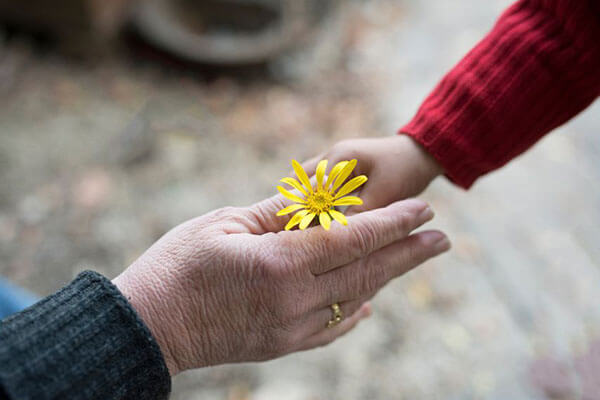When designing an apartment or house for seniors, it is essential to consider their unique needs that change over time. Unlike design for younger ages, design for seniors focuses on creating a safe home. Therefore, it is not enough to rely on a skilled designer, but also on a designer who knows the standards, accessories, and of course, is sensitive to this age so that, despite the limitations, it is still possible to create a home that is both functional and aesthetic, rather than heavy and old. Naturally, the home will also be functional and aesthetically pleasing.
Furthermore, the design process and changes involve transitioning to a smaller living space and eliminating stairs. This transition requires sensitivity towards individuals who may understand that it is time for change, despite the emotional challenges and possible resistance or denial regarding their situation.
If a couple has decided independently to move to another city to be closer to their children, or to make Aliya, or simply renovate their current apartment, temporary solutions must be found until the move to a more accessible and safe apartment
Transitioning from a larger apartment to a smaller one can be a challenging process. Still, with the right planning and a focus on the fundamental principles of safety, accessibility, aesthetics, and functionality, a protected and pleasant space can be created that meets the needs of seniors and their guests. Working collaboratively with interior design professionals can ensure that the transition is not just technical but also an enjoyable and memorable experience
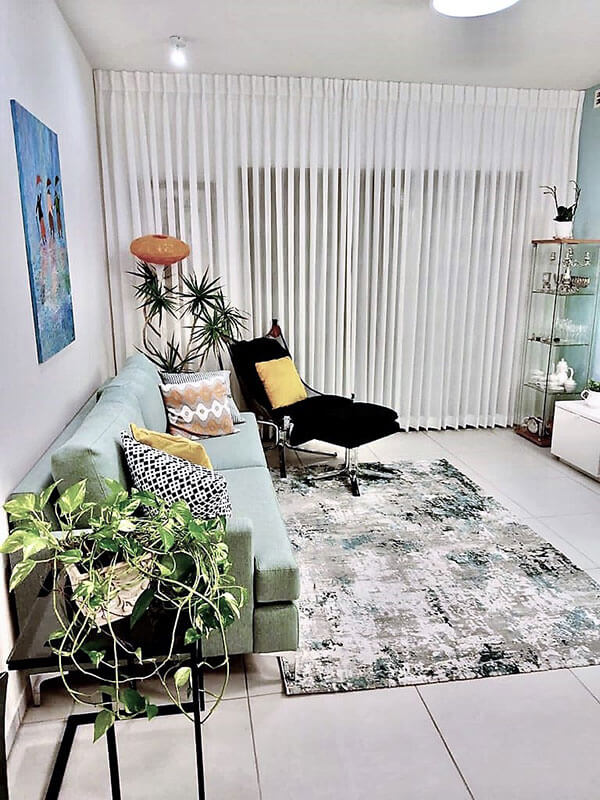
When moving from a larger apartment to a smaller one, it is necessary to concentrate on the belongings and items that will remain in the new environment. This process can be complex and often emotional. It is advisable to encourage clients to review the collections they want to take with them in a positive and pleasant atmosphere. This process will require them to select the most meaningful items and eliminate those that are unnecessary in the new space. Many of us are accustomed to filtering items such as utensils, books, clothes, and furniture pieces over the years. However, this time, the living space will possibly be smaller, making it easier to manage with fewer items and paperwork
Storage is a critical component in designing a small apartment for seniors, but not just for them. To maintain order, one can use furniture with built-in storage, such as beds with drawers underneath, featuring high-quality and easy-to-operate mechanisms, or sofas with storage compartments nearby. There is an option to design aesthetic sliding-door cabinets, integrated shelving units that will serve to store books and small items while maintaining a uniform and pleasant design line.
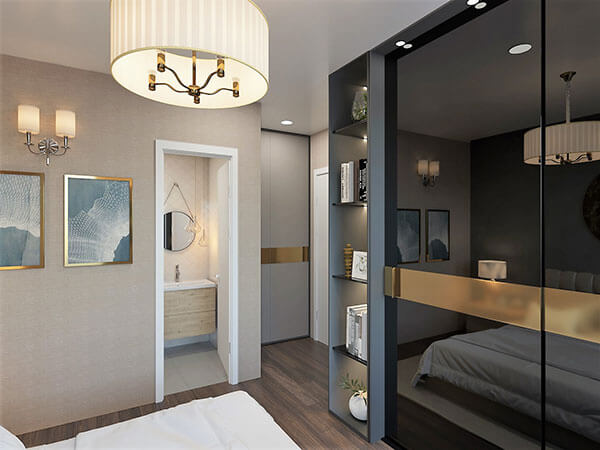
The furniture suppliers I have been working with for years offer comfortable, high-quality, functional, and aesthetic furnishings. Furniture with integrated storage can be an excellent solution when moving to a small apartment. Before meeting with them, I prepare storage solutions that suit the clients, ensuring a light, homogeneous, and minimalist look to avoid visual overload in public spaces and bedrooms. Furthermore, it must be easy to open the doors and drawers to access summer and winter clothing, maintaining separation and order to easily find and return clothing items after cleaning.
When planning design for seniors, special attention must be paid to safety. For example, aesthetic handrails can be added to walls for safety and stability, and support handles must be installed in bathrooms and other areas where there is a risk of slipping. A special and expensive bathroom door can solve the problem of helping someone who has slipped by blocking the entrance to the wet area. The door can open outward if possible, without colliding and hurting the partner, or it can be a high-quality sliding door with an internal pocket, which can sometimes be challenging for the elderly to maneuver, or a special double-directional door.
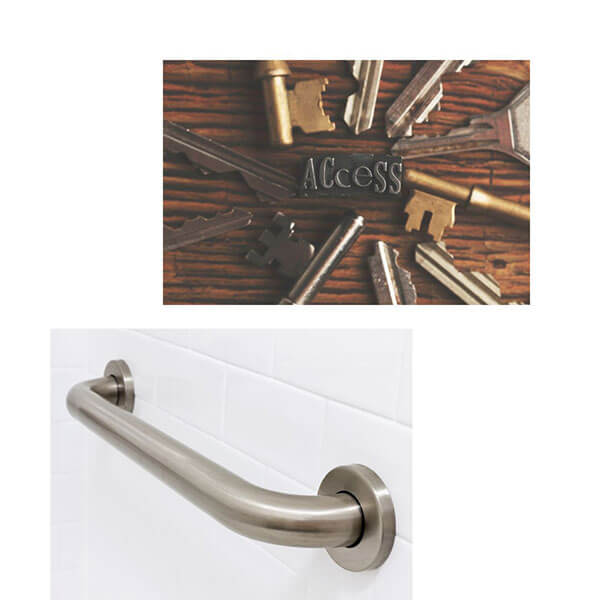
Of course, the size of the accessible bathroom should be large enough to allow comfortable access for a wheelchair and anyone assisting with bathing. One of the significant and necessary changes during renovations is expanding the bathroom area, transitioning to a long and wide shower that one can sit in. This often means that the bedroom's location will need to change. The distance between the bed and the wall must allow enough space to maneuver, often necessitating adjustments in the layout and size of these rooms. Sometimes, changing the location of the beds in the room will solve the desired space problem, and then it will be necessary to modify the positioning of the switches and outlets beside the bed and at the entrance to the new or existing room.

Hallways should be wide enough to facilitate easy movement for wheelchairs or other mobility aids, so the arms do not graze the walls. Cables should not be placed along the floor. This reminds me of clients whose husband tried to save costs by having numerous electrical cables running through the apartment, which made me afraid of tripping and distracted from our consultation discussion.
Also, some light switches and outlets will be at different heights than usual, lower to allow someone in a wheelchair to press the switch easily while seated.
Making the home environment accessible includes the parking area, sidewalk, vehicle, and path to the house. Various solutions are available, and several companies provide special equipment, some of which is also technological. People in their 60s planning home renovations, who are still young in body and spirit, would do well to incorporate some or all of the design for future accessibility.
In finding technological solutions, creating a smart home is a fantastic integration for those accustomed to technology. For individuals who have already fallen, I sometimes involve a physiotherapist specializing in seniors or a social worker who defines their limitations. All this is critical for mental health and quality of life. It is essential that individuals with mobility impairments do not fall into depression or feel socially isolated due to vision, hearing, or mobility impairments
Lighting design is a central element in quality design for small apartments and any living size. The lighting should be suitable for each room individually. Using soft and illuminating light fixtures can enhance the feeling within the space and eliminate shadows and "dark pockets," ensuring good visibility that isn't blinding. Sensitivity to lighting differs at this age as well as the sensitivity to noise.
Since uninterrupted sleep is infrequent at these ages, I always plan safe and pleasant solutions for nighttime lighting throughout the house that differ from daylight and primarily serve as orientation lighting.
The quality of lighting colors is essential to avoid a flickering light feeling. Please feel free to expand your reading in another article I wrote on "Basic Concepts in Lighting"
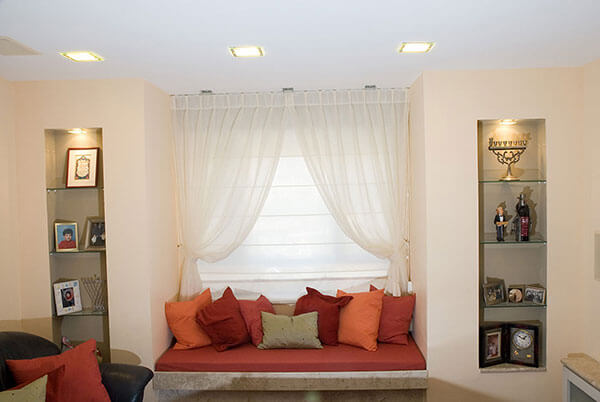
Soft and pastel wall colors can convey warmth and expand the feeling of space. Colors such as light blue, soft green, or beige can positively affect mood and make the home feel more pleasant. Additionally, it is possible to improve acoustics by using soft materials, such as flat rugs with non-slip backing to prevent slipping. Curtains can help reduce noise and make the home a more comfortable environment, while a designed headboard that runs along the bed wall adds to the aesthetic.
When designing a living room for a space intended for seniors, we must ensure that the area is safe, accessible, and comfortable for daily life. This room serves as the heart of the home, where family and friends gather, so attention must be given to details that provide comfort and security.
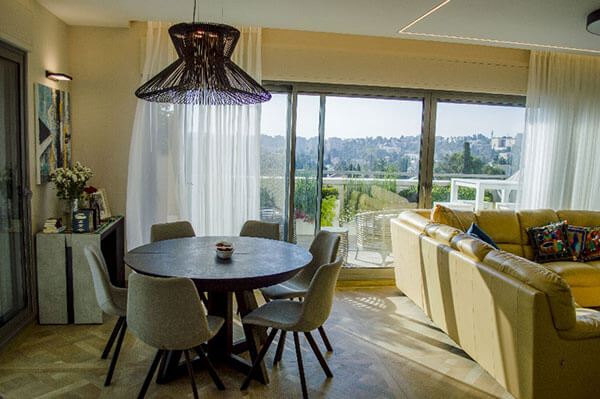
Customized Furniture Height: When planning the living room, it is vital to choose furniture at a comfortable height that is accessible for seniors. Sofas and chairs should be at a height that allows for easy sitting and standing without exerting pressure on the back or joints. Low furniture can be challenging for individuals with mobility issues
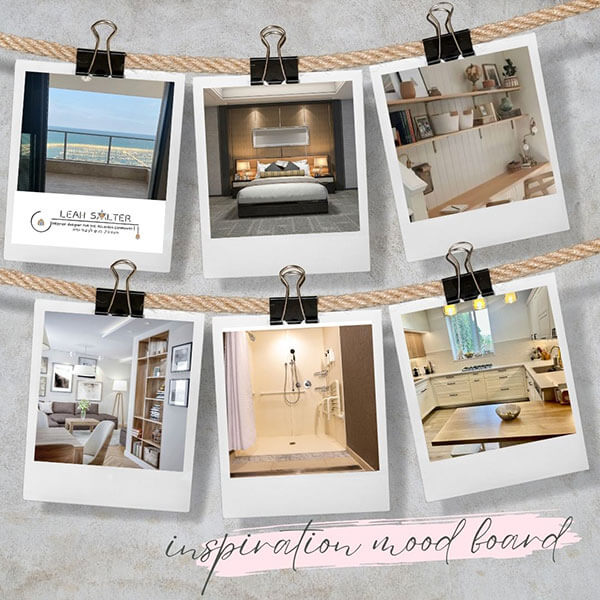
Functional Furniture: It is advisable to choose furniture with simple and practical designs to integrate smoothly with the rest of the space. Sofas with storage options create an excellent solution and help maintain order in the area.
Creating a sense of flow, ease, and comfortable movement between the furniture, which should not be dark or heavy, can prevent falls and accidents.
Open Space: The living room should be planned to have an open and accessible area for all users. Arranging the furniture in such a way that there is at least a two-meter distance between each piece will provide a comfortable and safe passage.
Pleasant Seating Area: Creating a circular or gathered seating arrangement where family can convene contributes to a warm and inviting atmosphere, enhancing the sense of community
No Rugs: To prevent slipping and falling, it is crucial to avoid using rugs in the living room. The materials on the floor should be made of non-slip materials, such as durable laminate or appropriate ceramic, to ensure safety.
Uniform Height Lines: The flooring should have a consistent depth to help prevent falls, avoiding sudden height differences
In every new project or renovation, there is always a reference to these crucial issues. The differences in the project for the elderly, and especially for those who observe Shabbat, are challenging and require double planning.
For hot water solutions for Shabbat, there are various options, and I will not go into details here.
In the field of heating and air conditioning, there are, of course, different solutions
If there is a budget for separate systems for heating and cooling, it is better to separate them for those sensitive to the air conditioning draft or noise, or to choose a very high-quality and expensive air conditioning system. And, of course, I will always present different solutions for heating the home, some of which will work with a system for heating water. I do believe that we have to be with a sustainable approach in order to save energy and to improve our everyday health routine
When designing interiors for small apartments, especially for the observant community, special emphasis should be placed on details that ensure a comfortable and aesthetically pleasing daily living experience

It is vital that the planning includes storage solutions that meet the unique needs of the tenants while preserving the aesthetics and accessibility of the space.
Customized Storage: In planning the kitchen, it is essential to focus on the size of the storage. It is important to have shelves and drawers that can accommodate the necessary number of utensil sets and also special items designated for Sabbath and Passover. This planning ensures that there will be a designated place for these items, maintaining order and aesthetics in the kitchen. I prefer avoiding tall cabinets that require the use of a ladder; at this age, stability can be compromised, so it is better to avoid risks. Therefore, some storage for Sabbath items will be placed in the dining area to ensure full accessibility without risk.
Two Sinks: Because sinks take up space, sometimes we may opt for a double sink or an additional sink on a half-island so that separation and convenience are still applicable. I prefer to choose materials that can easily be made kosher in preparation for Passover, both on work surfaces and in the sinks. Technology offers a wide variety of aesthetic and practical solutions.
To ensure that the kitchen is accessible for wheelchairs, there should be no cabinets under the sink or the stove. The dining table must also be at an appropriate height for an independent person who wants to sit and eat with everyone at the table in their wheelchair. There are various mechanisms that can open at the push of a button, an island that can be raised and lowered, and a faucet for pots common among Americans. Touch drawers will prevent knee injuries because the handle is integrated. The height of the countertop should be at the same level as the dining table for full accessibility. However, this can pose challenges with dish racks designed for standard countertop heights. Of course, there are various changes, but all these require careful planning.
Decorative Hand-Washing Station: If possible and if the clients still wish to host, I create a unique and decorative hand-washing area that could include a small sink, a soap dispenser, and a shelf for storing towels. It is important to ensure that the design integrates with the overall aesthetic of the kitchen and the public area, making it not only practical but also enhancing the overall aesthetic of the space
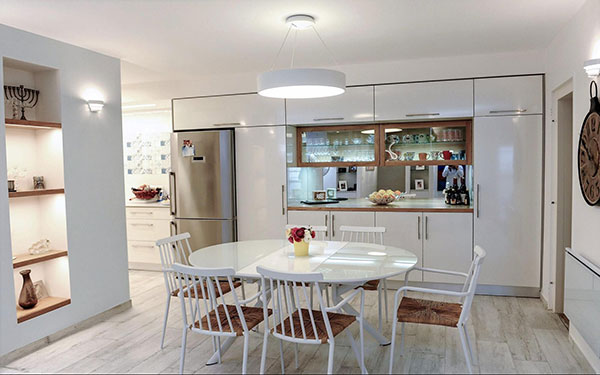
Stylish and Aesthetic Dining Area: The dining area can be designed for minimal family hosting, ensuring that it is comfortable and pleasant for both hosts and guests. The dining table should be designed to expand when necessary, with comfortable chairs suitable for family members, even if some will be stored and folded in a designated closet. This mechanism should be easy to open for enlarging the table, and extensions should be stored in the table structure to save space for additional storage. Lightweight legs that can lock prevent the table from moving, but there should still be room to tuck chairs or wheelchairs under the tabletop. If the space is small and cannot accommodate a large table, I may place a transparent glass table that appears to float in the room, not diminishing the feeling of space. Naturally, rounded corners should be prioritized, and since it's an advanced age, I won't introduce fragile or sharp-edged furniture that could pose a risk of injury due to loss of stability.
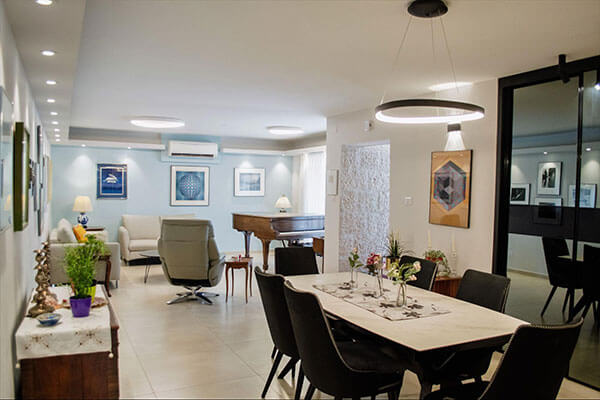
Integration with Public Space: Consideration should be given to how the dining area blends with the kitchen. An open design, where the dining area is adjacent to the kitchen, allows for a lifestyle that invites and connects culinary experiences with meals and family gatherings, saving space and providing a larger feeling of openness.
In designing the kitchen and dining area, careful planning of storage, especially when dealing with dairy and meat utensils, and potentially items for Sabbath and/or Passover, along with two sinks and a decorative hand-washing area, should seamlessly integrate with the public area, provided the space allows for it. It is unwise to overload with furniture items we have become accustomed to from the past; in this age group, it may not always be relevant to consider hosting in an apartment. Instead, it may be prudent to rent a space suitable for various family gatherings within a complex or at one of the children's homes. With professional and precise work, a home environment can be created that conveys the essential values of a Jewish home and family while concurrently providing warmth and comfort.
Another important aspect is how to adapt the space to be suitable for hosting the grandchildren. It is advisable to designate play areas or a movable additional seating area, such as ottomans, allowing for pleasant and meaningful family gatherings. Accessible storage for toys will enable enjoyment during gatherings, ensuring that parents return the toys to the designated storage at the end of their visit.
